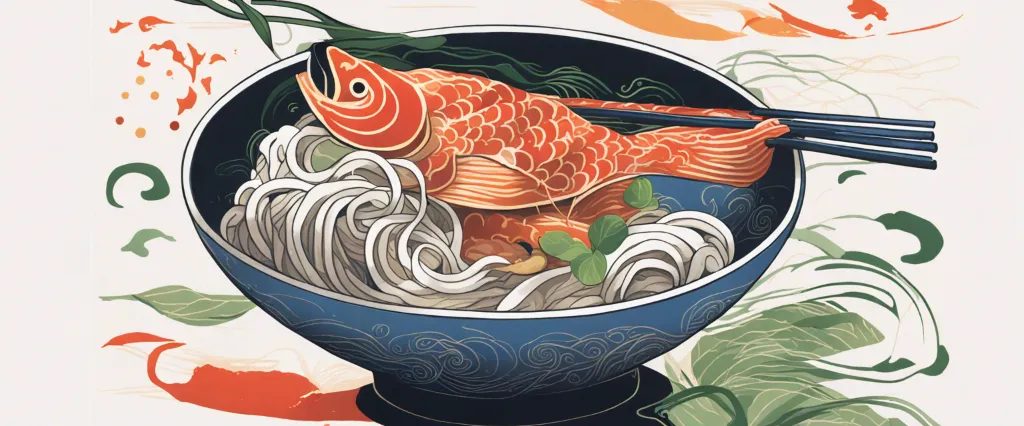
Culinary literature has the unique ability to transport readers to a world where food becomes a gateway to culture, history, and personal experiences. As we delve into the pages of books like “Rice Noodle Fish” by Matt Goulding and “The Omnivore’s Dilemma” by Michael Pollan, we discover more than just recipes or food preferences. These works offer vivid explorations of our complex relationship with food and expose the intricate interplay between culture, agriculture, and personal choices.
In “Rice Noodle Fish,” Matt Goulding takes us on a captivating journey through the bustling streets of Japan, unveiling the vibrant tapestry of regional cuisine. His culinary memoir combines vivid storytelling, captivating imagery, and expertly crafted recipes to paint a rich picture of Japan’s diverse food culture. On the other hand, Michael Pollan’s “The Omnivore’s Dilemma” plunges readers into a world of industrialized food systems and the hidden consequences they entail. Examining our modern food chain, Pollan prompts readers to question their own dietary choices, ultimately urging us to reassess the ethics of our consumption patterns.
This comparative study aims to explore the striking differences and common ground found within these two thought-provoking works. While both Goulding and Pollan address the subject of food, their narratives, underlying themes, and approaches differ significantly. By analyzing their distinct perspectives, we hope to gain a holistic understanding of our relationship with food as it resonates in different cultural and societal contexts.
By dissecting the experiences and insights shared by Goulding and Pollan, we will unravel their unique perspectives and examine the role of food not only as sustenance but also as an emblem of identity, history, and social change. Through their engaging narratives, readers are invited to ponder the implications of our dietary choices and their impact on our planet as well as our personal well-being.
This study will adopt a multi-faceted approach, incorporating aspects of cultural anthropology, culinary history, environmental sciences, and personal narratives. By examining the books through these lenses, we strive to reveal the broader implications that food choices have on the global community.
In the following sections, we will embark on an exquisite journey, comparing and contrasting the vivid narratives and insights presented by Goulding and Pollan. Exploring the varying contexts of Japan’s local culinary traditions and the complexities of modern industrialized food systems, this study will shed light on the multifaceted nature of our relationship with food.
Ultimately, by conducting this comparative study, we aim to deepen our understanding of the intricate connections between food, culture, and personal choices. Through the lens of these two seminal works, “Rice Noodle Fish” and “The Omnivore’s Dilemma,” we hope to inspire readers to critically evaluate their own food choices and embrace a more conscious approach to eating.
Brief Summary of Two Books
Rice Noodle Fish by Matt Goulding
“Rice Noodle Fish” by Matt Goulding is a food and travel book that explores the vibrant culinary scene of Tokyo, Japan. The author takes readers on a lyrical journey through the city, delving into its intriguing traditions, bustling markets, and hidden gems. Goulding introduces readers to the varied and delicious dishes of Tokyo, from humble street food to lavish Michelin-starred restaurants. Along the way, he highlights the people who bring Tokyo’s food culture to life, from passionate chefs to devoted street vendors. This beautifully illustrated book not only celebrates Tokyo’s rich gastronomic offerings but also provides valuable insight into its unique culture and history.
The Omnivore’s Dilemma by Michael Pollan
The Omnivore’s Dilemma by Michael Pollan is a thought-provoking exploration of the modern food industry and the choices we make as consumers. The book is divided into three main sections that delve into different aspects of our food system.
In the first section, Pollan delves into the industrial food chain, which dominates our grocery stores and fast-food restaurants. He uncovers the processes and practices that go into the production of popular food items, such as corn and meat, revealing the environmental and health consequences associated with them. He exposes the vast amounts of corn in our diets and the negative impacts of factory farming on animal welfare and the environment.
The second section explores alternative food systems, particularly focusing on organic farming and the local food movement. Pollan delves into the complexities of choosing organic food, discussing the challenges it faces and the potential benefits of supporting small-scale, sustainable agriculture. He visits various farms and markets, getting firsthand experience of alternative methods and highlighting their potential for a healthier and more environmentally friendly food system.
The final section takes the reader on a personal journey as Pollan decides to hunt and gather his own meal. He explores the ethical and environmental implications of consuming animals and forages for wild mushrooms. Through these experiences, he delves into the philosophical questions surrounding how we relate to our food and the connections between nature and food production.
In summary, The Omnivore’s Dilemma offers a comprehensive examination of our complex relationship with food, encouraging readers to consider the sources and implications of what we eat. Pollan challenges us to be more conscious consumers and to seek out more sustainable and healthier alternatives to the industrial food system.
Comparison between Two Books

Similarities in food culture
Both “Rice Noodle Fish” by Matt Goulding and “The Omnivore’s Dilemma” by Michael Pollan delve into the complex world of food culture, albeit from different perspectives. Despite their different focuses, there are some similarities that can be drawn between the two books:
1. Exploration of Local Food: Both books emphasize the importance of understanding and appreciating local food culture. “Rice Noodle Fish” takes readers on a journey through Tokyo’s diverse culinary scene, while “The Omnivore’s Dilemma” explores the American food system. In both cases, the authors highlight the value of supporting local farmers and traditional food practices.
2. Environmental Considerations: Both authors delve into the environmental impact of the food industry. “Rice Noodle Fish” discusses sustainable fishing practices in Japan and the threats to marine ecosystems, while “The Omnivore’s Dilemma” investigates the destructive nature of industrial agriculture in America. Both books shed light on the need for more sustainable and responsible food production.
3. Connection to Nature and Food Origins: Both books emphasize the importance of understanding where our food comes from. “Rice Noodle Fish” focuses on the relationship between Japanese people and their food sources, while “The Omnivore’s Dilemma” explores the origins of various food products, such as corn and grass-fed beef. Both authors highlight the value of reconnecting with nature and realizing the true origins of our meals.
4. Cultural Significance of Food: Both books explore the cultural significance of food and its role in shaping communities. “Rice Noodle Fish” delves into the rich history and traditions of Japanese cuisine, while “The Omnivore’s Dilemma” investigates the impact of food on American culture and identity. Both books recognize that food is more than just sustenance; it is a reflection of our heritage and a way to connect with others.
In summary, while “Rice Noodle Fish” and “The Omnivore’s Dilemma” approach the topic of food culture through different lenses, they share common themes such as the exploration of local food, environmental considerations, the connection to nature and food origins, and the cultural significance of food. Both books provide valuable insights into the complex and multifaceted world of our relationship with food.
Divergences in food culture
Rice Noodle Fish by Matt Goulding and The Omnivore’s Dilemma by Michael Pollan are both notable books that delve into the world of food culture, albeit from different perspectives. While both explore the impact of food on society, there are noticeable divergences in terms of focus, geographical scope, and tone.
One of the main differences between the two books lies in their respective focal points. Rice Noodle Fish primarily revolves around the author’s personal journey through the diverse food landscape of Japan. Goulding immerses himself in the local food scene, exploring regional specialties, and tracing the roots of Japanese cuisine. In contrast, The Omnivore’s Dilemma takes a broader approach, examining the industrial food complex within the United States. Pollan investigates the entire food chain, from the origins of food production to its ultimate consumption, in an attempt to understand the implications of mass food production on the environment and human health.
Geographical scope is another aspect where these books diverge. Rice Noodle Fish maintains a tight focus on Japan, highlighting the nuances and intricacies of the country’s cuisine. Goulding paints a vivid picture of Japan’s food culture, discussing everything from traditional ramen shops to cutting-edge culinary creations. On the other hand, The Omnivore’s Dilemma covers a wider range of geographical locations within the United States. Pollan investigates everything from industrial cornfields in Iowa to organic farms in California, offering a multifaceted view of the American food culture and its societal consequences.
Furthermore, the two books differ in terms of their tone and overall approach to food culture. Rice Noodle Fish by Matt Goulding is more celebratory and enthusiastic. Goulding showcases his appreciation for Japanese culinary traditions, storytelling, and the overall dining experience. He highlights the passion of local chefs and the cultural significance of each dish, inviting readers to accompany him on his journey of culinary discovery. Conversely, The Omnivore’s Dilemma takes a critical stance, examining the negative impacts of industrial food systems and revealing the hidden truths behind the American food culture. Pollan’s writing is more investigative in nature, presenting facts, figures, and historical context to underscore his arguments.
In conclusion, while both Rice Noodle Fish by Matt Goulding and The Omnivore’s Dilemma by Michael Pollan delve into the world of food culture, they have distinct divergences. Rice Noodle Fish focuses primarily on the author’s exploration of Japanese cuisine, while The Omnivore’s Dilemma takes a wider perspective on the US food industry. They also differ in terms of geographical scope, exploring Japan versus various locations within the United States. Furthermore, the tone of the books diverges, with Rice Noodle Fish celebrating culinary traditions, and The Omnivore’s Dilemma adopting a more critical and investigative approach.

Conclusion
Both “Rice Noodle Fish” by Matt Goulding and “The Omnivore’s Dilemma” by Michael Pollan are highly regarded books in their respective genres, so determining which one is more worthy of reading ultimately depends on your personal interests and preferences.
“Rice Noodle Fish” is a travel memoir that explores the vibrant food culture of Japan, specifically Tokyo. It delves into the diverse culinary traditions, regional specialties, and the people behind Japan’s food scene. If you have a passion for travel, culture, and food, this book could be a captivating and informative read.
On the other hand, “The Omnivore’s Dilemma” is a non-fiction work that examines the modern industrial food system in the United States. Michael Pollan delves into topics such as factory farming, organic agriculture, and the ecological impact of our food choices. This book is suitable for those interested in understanding the complexities of the food industry and its impact on our health and the environment.
Ultimately, it would be best to consider your specific interests to determine which book aligns more closely with what you want to explore.



